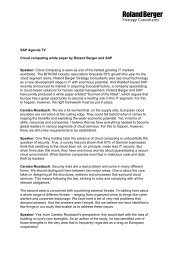"Automotive inSIGHTS 2/2010" (PDF, 3784 KB - Roland Berger
"Automotive inSIGHTS 2/2010" (PDF, 3784 KB - Roland Berger
"Automotive inSIGHTS 2/2010" (PDF, 3784 KB - Roland Berger
Create successful ePaper yourself
Turn your PDF publications into a flip-book with our unique Google optimized e-Paper software.
A LOOK AROUND THE WORLD<br />
What then would the applications for EVs be? They should<br />
be limited to short-range transportation in urban areas,<br />
as priority is given to safety. Applications may also expand<br />
to include commercial uses such as pickup and delivery<br />
vehicles used on a particular route, private uses like car<br />
sharing and so on.<br />
The potential of expansion largely depends on consumers'<br />
first impressions of EV. One user took a 20-minute drive<br />
through his neighborhood via EV car sharing (Fig. 2). His<br />
conclusion was: "will not use anymore since it offers no<br />
reliability". This was based on his report that: "Driving<br />
range was halved when the heater was turned on. Cannot<br />
trust it any more"; "Driving range was given as 90 km with<br />
a 95% charge, although it should be 160 km at 100%";<br />
"The silence felt so weird. Might get used to it, but still<br />
feel anxious as it is too quiet"; "It took 10 minutes to<br />
fit the charging socket. Cannot do this every day".<br />
In contrast, another user enjoyed a long-distance drive<br />
to the suburbs with a rental car. His impression after<br />
the drive was that "the EV is practical enough". He understood<br />
through actual experience that the driving range –<br />
the biggest initial concern – was not such a problem.<br />
1) The number of pilot cities has already reached 25 and will increase steadily<br />
Everything takes some getting used to. Especially for cars:<br />
people have a certain image from conventional engine<br />
cars, and a new vehicle like an EV might at first create an<br />
uncomfortable impression. But this discomfort does not<br />
last long. Acceptance of EVs depends heavily on whether<br />
drivers can be given enough time behind the wheel to get<br />
used to the new sensation.<br />
Popularizing EVs in Japan depends on the amount of effort<br />
and information on the part of the provider. Careful prepa-<br />
ration, such as developing a vehicle that will be accepted<br />
by consumers who put a premium on security and safety,<br />
will be necessary, as will offering test drives so that<br />
consumers can experience the car's practicality for<br />
themselves.<br />
Meanwhile, EV popularization in China is due largely to<br />
government policy (Fig. 3). Full-fledged popularization of<br />
private cars still has a ways to go, given that the largescale<br />
EV project "10 cities, 1,000 vehicles" 1) still focuses on<br />
public transportation such as buses and taxis. However,<br />
the growth of the Chinese automobile market pushed it<br />
almost to number one in just 10 years. There is still plenty<br />
of room for EVs on the market, and they are likely to gain<br />
popularity rapidly, if the right product is launched.<br />
7

















